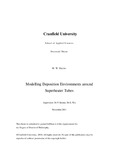JavaScript is disabled for your browser. Some features of this site may not work without it.
| dc.contributor.advisor | Simms, Nigel J. | |
| dc.contributor.advisor | Wu, S. | |
| dc.contributor.author | Davies, Martyn W. | |
| dc.date.accessioned | 2013-03-15T11:37:44Z | |
| dc.date.available | 2013-03-15T11:37:44Z | |
| dc.date.issued | 2011-11 | |
| dc.identifier.uri | http://dspace.lib.cranfield.ac.uk/handle/1826/7866 | |
| dc.description.abstract | In an important initiative to reduce carbon dioxide emission from pulverized fuel boilers, coal is now co-fired with biomass. During the combustion process, however, chlorine and sulphur in chemical compounds associated with sodium and potassium are released in a form which can deposit onto and then corrode the steel heat exchanger tubes. The deposition and corrosion can have serious implications for the power generation industry because the corrosive damage on heat exchange tubes can shorten the operational life of the boilers and lead to significant economic penalties. The deposition and corrosion processes have been widely studied but eliminating the deposits and corrosive materials is still a challenging problem. Computational fluid dynamics (CFD) has been used to model the deposition processes and it mainly focuses on experimentally deriving constants in the models that capture some aspects of the problem such as the motion behaviour of aerosols. However, using CFD has a limitation that results in periodic instability when solving the models with numerical computation. Modelling deposition environments around superheater tubes is a complex problem as many aspects, such as particle motion, condensation of matter and continuous combustion of particles, should be considered.This thesis has: (1) developed a new mathematical approach that uses mesh-free methods to solve Hamilton’s equations with a consideration of the total energy of the system, where the Hamilton’s equation is scale independent; (2) developed a model that can simulate the mass accumulation process based on graph and combinatorics theory; (3) developed a model depicting the continuous combustion of particles in motion; (4) developed a model depicting the behaviour of changing matter states; (5) developed a model depicting the vapour phase deposition on particles; and (6) verified the developed models with case studies. This work shows the importance of homogenous and heterogeneous vapour depositions on binding particles onto superheater tubes. | en_UK |
| dc.language.iso | en | en_UK |
| dc.publisher | Cranfield University | en_UK |
| dc.rights | ©Cranfield University, 2010. All rights reserved. No part of this publication may be reproduced without permission of the copyright holder. | en_UK |
| dc.title | Modelling deposition environments around superheater tubes | en_UK |
| dc.type | Thesis or dissertation | en_UK |
| dc.type.qualificationlevel | Doctoral | en_UK |
| dc.type.qualificationname | PhD | en_UK |
